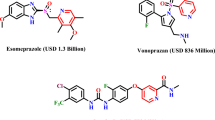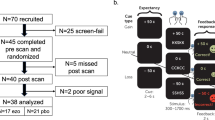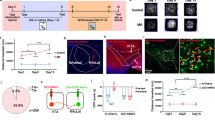Abstract
The cyclin-dependent kinase Cdk5 and DARPP-32 (dopamine- and cAMP-regulated phosphoprotein of Mr 32?kDa)-dependent signaling have been implicated in the regulation of dopaminergic neurotransmission after chronic cocaine treatment. In this study, we examined if Cdk5 signaling participates in the behavioral and biochemical effect of acute and chronic methamphetamine (METH) treatment. We found that Cdk5 activity and the membrane fraction of p35 protein, a Cdk5 activator, in the ventral striatum increased transiently after an injection of 4?mg/kg METH, while intra-accumbens treatment with a Cdk5 inhibitor, roscovitine, prevented the acute METH-induced locomotor activation. The phosphorylation of DARPP-32 at both Thr75 and Thr34 was differentially regulated after acute METH treatment, but the levels of total Cdk5, p35, and DARPP-32 remained the same. To determine if Cdk5 signaling was associated with behavior sensitization to METH, rats that received repetitive injections of METH (4?mg/kg) for 14 consecutive days were analyzed at withdrawal day 7. The results indicate that Cdk5 activity and p35 translocation in the ventral striatum were upregulated in METH-sensitized rats; treatment with roscovitine in the nucleus accumbens effectively suppressed the 1?mg/kg METH-induced behavioral sensitization. Concomitantly, a decrease in the amount of PP-2A and DARPP-32 phosphorylation at Thr34, but an increase in phosphorylation of DARPP-32/Thr75, was observed in the ventral striatum of sensitized rats. The overall results demonstrate that Cdk5/p35 and downstream signaling in the ventral striatum play a critical role in the effects of acute METH treatment as well as the development of behavioral METH sensitization.
Similar content being viewed by others
Log in or create a free account to read this content
Gain free access to this article, as well as selected content from this journal and more on nature.com
or
References
Amitabh G, Tsai LH (2001). A kinase to dampen the effects of cocaine? Science 292: 236–239.
Bibb JA, Chen JS, Taylor JR, Svenningsson P, Nishi A, Snyder GL et al (2001). Effects of chronic exposure to cocaine are regulated by the neuronal protein Cdk5. Nature 410: 376–380.
Bibb JA, Synder GL, Nishi A, Yan Z, Meijer L, Fienberg AA et al (1999). Phosphorylation of DARPP-32 by cdk5 modulates dopamine signaling in neurons. Nature 402: 669–671.
Cador M, Bjijou Y, Stinus L (1995). Evidence of a complete independence of the neurobiological substrates for the induction and expression of behavioral sensitization to amphetamine. Neuroscience 65: 385–389.
Cador M, Bjijou Y, Stinus L (1999). d-Amphetamine-induced behavioral sensitization: implication of a glutamatergic medial prefrontal cortex-ventral tegmental area innervation. Neuroscience 94: 705–711.
Chiang YC, Chen PC, Chen JC (2003). Dopamine D3 receptor down-regulation and functional desensitization in the olfactory tubercle of amphetamine-sensitized rats. Brain Res 972: 159–167.
Dhavan R, Tsai LH (2001). A decade of CDK5. Nat Rev 2: 749–759.
Ferrer-Alcon M, Harpe RL, Guimon J, Garcia-Sevilla JA (2003). Downregulation of neuroal cdk5/p35 in opioid addicts and opiate-treated rats: relation to neurofilament phosphorylation. Neuropsychopharmacology 28: 947–955.
Grant P, Sharma P, Pant HC (2001). Cyclin-dependent protein kinase 5 (CDK5) and the regulation of neurofilament metabolism. Eur J Biochem 268: 1534–1546.
Greengard P (2001). The neurobiology of slow synaptic transmission. Science 294: 1024–1030.
Greengard P, Allen P, Nairn AC (1999). Beyond the dopamine receptor: the DARPP-32/protein phosphatase-1 cascade. Neuron 23: 435–437.
Groenewegen HJ, Mulder AB, Beijer AVJ, Wright CI, Lopes da Silva FH, Pennartz CMA (1999). Hippocampal and amygdaloid interactions in the nucleus accumbens. Psychobiology 27: 149–164.
Gupta A, Tsai LH (2001). A kinase to dampen the effects of cocaine. Science 292: 236–239.
Hsieh HC, Li HY, Lin MY, Chiou HY, Lin SY, Wong CH et al (2002). Differential expression of haloperidol-induced immediate early genes and CREB/ pCREB binding in the nucleus accumbens of amphetamine-sensitized rats. Synapse 45: 230–244.
Kalivas PW, Stewart J (1991). Dopamine transmission in the initiation and expression of drug- and stress-induced sensitization of motor activity. Brain Res Rev 16: 223–244.
Keiz M, Chen J, Carlezon WA, Whisler K, Gilden L, Beckmann AM et al (1999). Expression of the transcription factor ΔFosB in the brain controls sensitivity to cocaine. Nature 401: 272–275.
Koob GF (1996). Drug addiction: the yin and yang of hedonic homeostasis. Neuron 16: 893–896.
Kuczenski R, Segal DS (1999). Sensitization of amphetamine-induced stereotyped behaviors during the acute response. J Pharmacol Exp Ther 288: 699–709.
Lew J (1994). Neuronal cdc2-like kinase is a complex of cyclin-dependent kinase 5 and a novel brain-specific regulatory subunit. Nature 371: 423–425.
Liu F, Ma XH, Ule J, Bibb JA, Nishi A, Demaggio AJ et al (2001). Regulation of cyclin-dependent kinase 5 and casein kinase 1 by metabotropic glutamate receptors. Proc Natl Acad Sci 98: 11062–11068.
Lu L, Grimm JW, Shaham Y, Hope BT (2003). Molecular neuroadaptations in the accumbens and ventral tegmental area during the first 90 days of forced abstinence from cocaine self-administration in rats. J Neurochem 85: 1604–1613.
Maccioni RB, Otth C, Concha II, Munoz JP (2001). The protein kinase cdk5. Eur J Biochem 268: 1518–1527.
Nestler EJ (2001). Molecular basis of long-term plasticity underlying addiction. Nat Rev 2: 119–128.
Nestler EJ, Aghajanian GK (1997). Molecular and cellular basis of addiction. Science 278: 58–63.
Nishi A, Bibb JA, Matsuyama S, Hamada M, Higashi H, Nairn AC et al (2002). Regulation of DARPP-32 dephosphorylation at PKA-and cdk5-sites by NMDA and AMPA receptors: distinct roles of calcineurin and protein phosphatase-2A. J Neurochem 81: 832–841.
Nishi A, Bibb JA, Snyder G, Higashi H, Nairn AC, Greengard P (2000). Amplification of dopaminergic signaling by a positive feedback loop. Proc Natl Acad Sci 97: 12840–12845.
Norrholm SD, Bibb JA, Nestler EJ, Ouimet CC, Taylor JR, Greengard P (2003). Cocaine-induced proliferation of dendritic spines in nucleus accumbens is dependent on the activity of cyclin-dependent kinase-5. Neuroscience 116: 19–22.
Paxinos G, Watson C (1996). The Rat Atlas in Stereotaxic Coordinates. Academic Press: San Diego.
Robinson TE, Becker JB (1986). Enduring changes in brain and behavior produced by chronic amphetamine administration: a review and evaluation of animal models of amphetamine psychosis. Brain Res Rev 11: 157–198.
Robinson TE, Kolb B (1997). Persistent structural modifications in nucleus accumbens and prefrontal cortex neurons produced by previous experience with amphetamine. J Neurosci 17: 8491–8497.
Robinson TE, Kolb B (1999). Alternations in the morphology of dendrites and dendritic spines in the nucleus accumbens and prefrontal cortex following repeated treatment with amphetamine or cocaine. Eur J Neurosci 11: 1598–1604.
Self DW, Nestler EJ (1995). Molecular mechanisms of drug reinforcement and addiction. Annu Rev Neurosci 18: 463–495.
Sharma P, Sharma M, Amin ND, Albers RW, Pant HC (1999). Regulation of cyclin-dependent kinase 5 catalytic activity by phorphorylation. Proc Natl Acad Sci USA 96: 11156–11160.
Smith DS, Greer PL, Tsai LH (2001). Cdk5 on the brain. Cell Growth Diff 12: 277–283.
Smith DS, Tsai LH (2002). Cdk5 behind the wheel: a role in trafficking and transport? Trends Cell Biol 12: 28–36.
Svenningsson P, Nishi A, Fisone G, Girault J-A, Nairn AC, Greengard P (2004). DARPP-32: an integrator of neurotransmission. Annu Rev Pharmacol Toxicol 44: 269–296.
Todtenkopf MS, Stellar JR (2000). Assessment of tyrosine hydroxylase immunoreactive innervation in five subregions of the nucleus accumbens shell in rats treated with repeated cocaine. Synapse 38: 261–270.
Vanderschuren LJMJ, Kalivas PW (2000). Alterations in dopaminergic and glutamatergic transmission in the induction and expression of behavioral sensitization: a critical review of preclinical studies. Psychopharmacology 151: 99–120.
White FJ, Cooper DC (2001). The vicious cyclin of addiction. Nat Med 7: 416–418.
Acknowledgements
We thank Dr Jerome L Maderdrut of Tulane University for his assistance in editing this manuscript, and Drs Angus C Nairn and Paul Greengard of Rockefeller University for generously providing the anti-DARPP-32/Thr34 and anti-DARPP-32/Thr75 antibodies. The study was supported by Grants NSC90-2314-B-182A-139 from the National Science Council and CMRP1375 from Chang-Gung Memorial Hospital, Taiwan, ROC.
Author information
Authors and Affiliations
Corresponding author
Rights and permissions
About this article
Cite this article
Chen, PC., Chen, JC. Enhanced Cdk5 Activity and p35 Translocation in the Ventral Striatum of Acute and Chronic Methamphetamine-Treated Rats. Neuropsychopharmacol 30, 538–549 (2005). https://doi.org/10.1038/sj.npp.1300604
Received:
Revised:
Accepted:
Published:
Issue date:
DOI: https://doi.org/10.1038/sj.npp.1300604
Keywords
This article is cited by
-
Ifenprodil Attenuates Methamphetamine-Induced Behavioral Sensitization Through the GluN2B-PP2A-AKT Cascade in the Dorsal Striatum of Mice
Neurochemical Research (2020)
-
Short and long access to cocaine self-administration activates tyrosine phosphatase STEP and attenuates GluN expression but differentially regulates GluA expression in the prefrontal cortex
Psychopharmacology (2013)
-
The internal state of medium spiny neurons varies in response to different input signals
BMC Systems Biology (2010)
-
Caffeine and a selective adenosine A2A receptor antagonist induce reward and sensitization behavior associated with increased phospho-Thr75-DARPP-32 in mice
Psychopharmacology (2009)
-
Quantitative Trait Locus Analysis Identifies Rat Genomic Regions Related to Amphetamine-Induced Locomotion and Gαi3 Levels in Nucleus Accumbens
Neuropsychopharmacology (2008)



